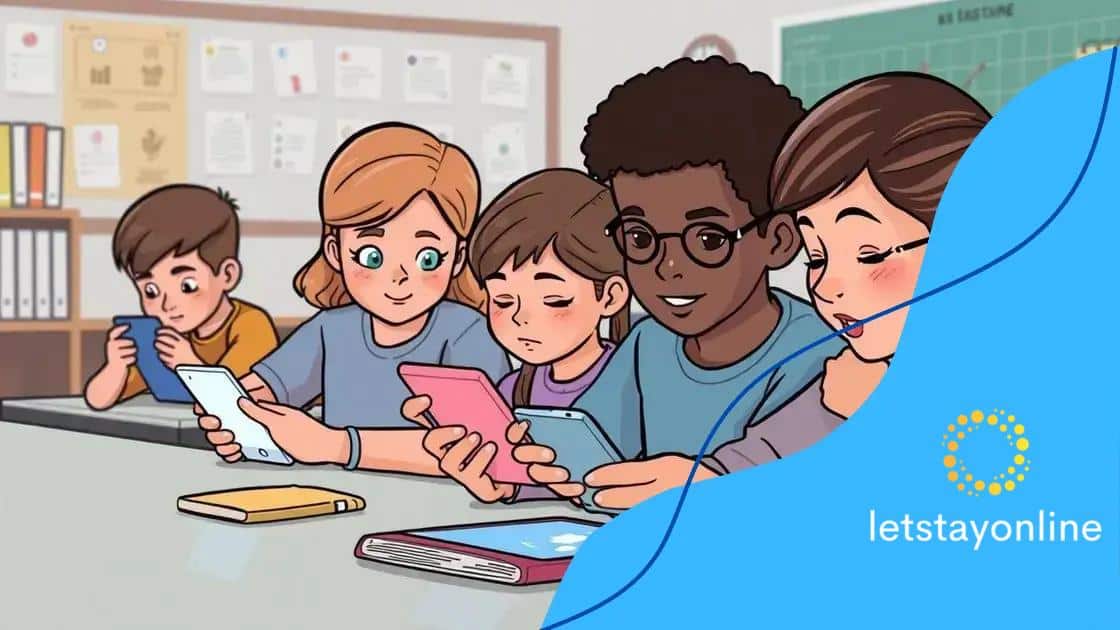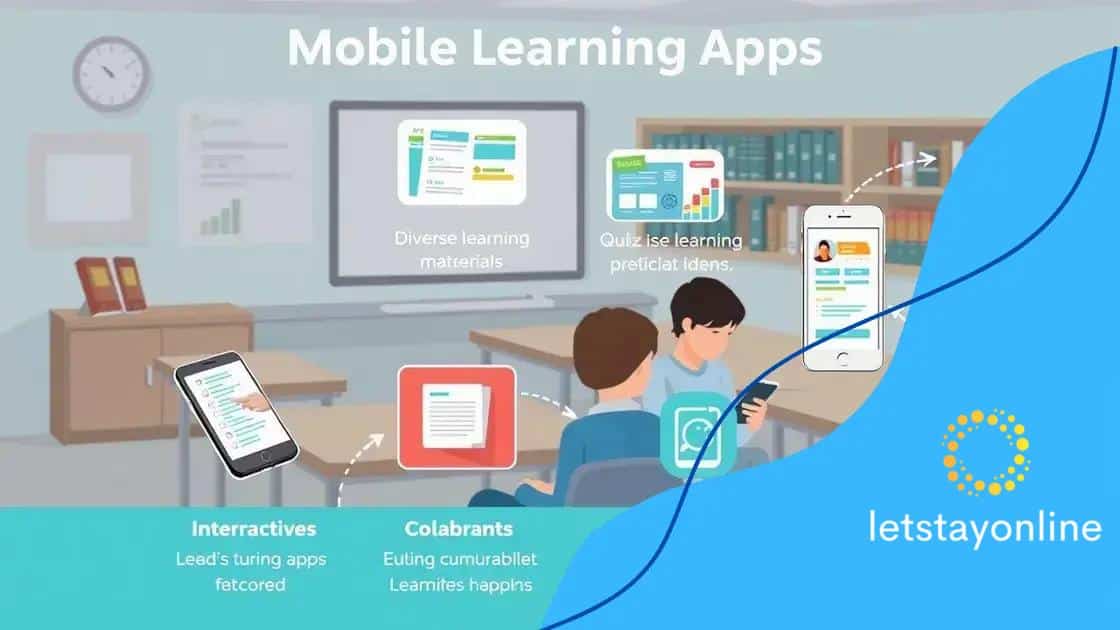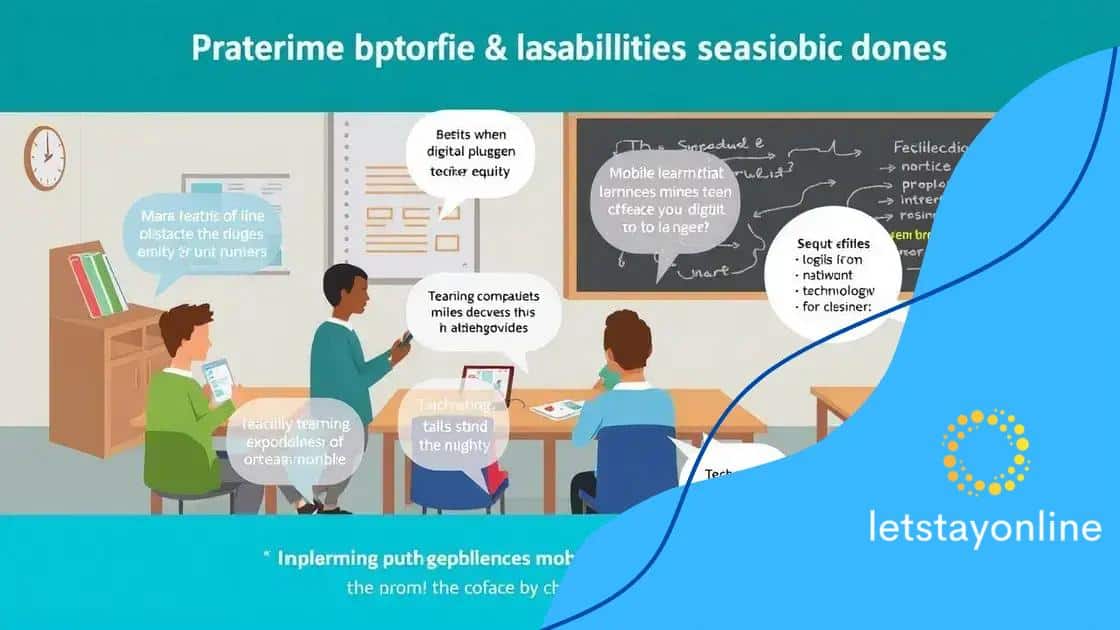Mobile learning apps for K-12 students: the complete guide

Mobile learning apps for K-12 students enhance education by providing personalized learning experiences, interactive content, and access to diverse resources, while also addressing challenges like digital equity and teacher training.
Mobile learning apps for K-12 students are changing how our children learn. Have you considered how these tools enhance education, engage students, and adapt to their needs? Let’s explore what makes them so transformative.
Understanding mobile learning in K-12 education
Understanding mobile learning in K-12 education is essential for recognizing how technology influences today’s classrooms. With the rise of mobile devices, teachers and students have new opportunities to engage with educational content.
Mobile learning fosters an interactive environment that can be tailored to each student’s needs. This personalized approach ensures that learners grasp concepts in ways that resonate with them. For example, using educational apps enhances certain skills while keeping students entertained. Let’s dive deeper.
Defining Mobile Learning
Mobile learning refers to any educational activity that occurs through mobile devices. This includes smartphones, tablets, and laptops. Such flexibility allows students to learn at their own pace, inside or outside the classroom.
Benefits of Mobile Learning
- Enhances accessibility for all students.
- Provides resources that cater to various learning styles.
- Encourages collaboration among peers.
- Offers instantaneous feedback, improving learning outcomes.
As mobile learning apps proliferate, they change the landscape of K-12 education. The ability to access materials anywhere means that learning extends beyond the school walls. Students are no longer confined to textbooks; they can explore vast resources anytime.
Moreover, mobile learning supports diverse educational needs. For students with learning disabilities, customized apps offer unique ways to engage with the material. This fosters inclusivity, ensuring that every student has the tools they need to succeed.
Challenges in Mobile Learning
However, it’s not all smooth sailing. Some challenges exist within mobile learning implementations. Issues like digital equity need addressing; not every student has access to robust devices or reliable internet. Teachers also require proper training to effectively integrate these technologies into their teaching. Therefore, balancing these challenges with innovation is vital for success.
The journey of mobile learning in K-12 education is ongoing. As schools adapt, the potential for growth and improvement is immense. By embracing technology, we can shape an enriched learning environment for all students and equip them with skills for the future.
Key features of effective mobile learning apps

Key features of effective mobile learning apps are crucial for ensuring that educational experiences are impactful and engaging. These features define how well an app meets the needs of students and educators alike.
When designing mobile learning apps, developers focus on user-friendly interfaces. An intuitive design allows students to navigate easily and find resources without frustration. This accessibility creates a seamless learning environment that promotes effective study habits.
Engagement and Interactivity
Another important aspect is interactivity, which keeps students engaged. Apps should offer quizzes, games, and interactive content to make learning enjoyable. This interactive approach helps solidify knowledge through active participation.
Accessible Learning Materials
- Variety of formats: Text, audio, and video options cater to different learning styles.
- Offline access: Students can download materials and study without needing a stable internet connection.
- Regular updates: Up-to-date content ensures relevance and accuracy.
Moreover, the ability to personalize learning experiences is a key feature. Many mobile apps allow students to set goals, track progress, and receive feedback tailored to their needs. This personalization makes learning more relevant and motivating.
Security also plays a significant role. Protecting student data is essential, so effective apps implement security measures to ensure a safe learning environment. Features like password protection and data encryption build trust in users.
Collaboration Tools
Collaboration is another vital function of mobile learning applications. These apps should facilitate communication among students and between students and teachers. Features like discussion boards, group projects, and messaging tools are important for a holistic learning experience.
The overall design of mobile learning apps should prioritize usability and adaptability. As technology evolves, these apps must keep up with changing educational demands, ensuring that they remain valuable resources in the classroom and beyond.
Benefits of mobile learning apps for students
Benefits of mobile learning apps for students extend far beyond traditional education methods. These innovative tools enhance the learning experience and cater to individual needs.
One major advantage is flexibility. Mobile learning apps allow students to learn at their own convenience, whether at home or on the go. This flexibility helps them balance their studies with extracurricular activities.
Personalized Learning Experiences
These apps often offer personalized learning paths. Each student can progress at their own pace, focusing on areas where they need more practice or support. This tailored approach makes learning more relevant and effective.
Enhanced Engagement
- Interactive content captures students’ attention.
- Gamified elements make learning fun and competitive.
- Instant feedback keeps students motivated and informed.
- Collaborative features foster teamwork among peers.
Another critical benefit is improving access to resources. Mobile apps provide a range of materials—from videos to e-books—making learning more diverse and enriching. Students can explore subjects in various formats that suit their learning styles.
Mobile learning apps also encourage self-directed learning. Students can set goals, track their progress, and explore topics that interest them. This independence builds confidence and fosters a love for learning.
Cost-Effective Learning
Cost-effectiveness is another advantage of mobile learning. Many educational apps are available for free or at a low cost. This accessibility enables more students to benefit from quality educational resources, regardless of their economic background.
Moreover, using mobile learning apps helps develop digital literacy skills. As students navigate technology, they become more prepared for future careers in a technology-driven workforce. These skills are essential in today’s digital age, preparing students for success both academically and professionally.
Challenges in implementing mobile learning solutions

Challenges in implementing mobile learning solutions can pose significant obstacles for educators and institutions. While mobile learning offers many benefits, there are hurdles that must be addressed for successful implementation.
One major challenge is digital equity. Not all students have access to the necessary devices or reliable internet connections. This inequality can create a gap in learning opportunities. Schools must find ways to provide resources to underserved students to ensure everyone benefits equally.
Training Educators
Another hurdle is the need for adequate training for teachers. Many educators may not be familiar with the latest technology or how to integrate mobile learning into their curriculum. Professional development programs are essential for equipping teachers with the skills they need to effectively use these tools.
Technological Challenges
- Device compatibility issues can arise, making it difficult for students to access content.
- Software updates may require technical support, causing downtime for students and teachers.
- Cybersecurity threats are a constant concern, necessitating robust protective measures.
Additionally, schools may struggle with program funding. Implementing mobile learning solutions requires financial investment in technology and software. This can be challenging, especially for districts with limited budgets. Creative funding strategies and community partnerships can help mitigate these costs.
Moreover, ensuring student engagement in mobile learning environments can be tricky. With so many distractions available on mobile devices, maintaining a focus on academic tasks is essential. Teachers must use engaging content and interactive features to keep students motivated.
Curriculum Alignment
Aligning mobile learning tools with existing curriculum frameworks is another challenge. Apps and programs must support educational standards while remaining adaptable to various learning environments. This alignment is crucial for achieving educational goals.
Thus, while mobile learning offers exciting possibilities, addressing these challenges is critical for effective implementation. By recognizing and tackling potential obstacles, educators can create an enriching and equitable learning experience for all students.
Future trends in mobile education technology
Future trends in mobile education technology indicate an exciting evolution in how learning occurs. As technology continues to advance, we can expect mobile education to become even more integrated into students’ daily lives.
One of the most significant trends is the rise of artificial intelligence (AI) in educational apps. AI can provide personalized learning experiences, adapting to individual student needs. By assessing performance and learning styles, AI can help deliver tailored educational content, making learning more effective.
Virtual and Augmented Reality
Another promising direction is the integration of virtual reality (VR) and augmented reality (AR)
As mobile technology becomes more sophisticated, we can also expect to see increased emphasis on adaptive learning. This approach involves using algorithms to curate content and resources based on students’ progress and comprehension levels. This ensures that every learner receives the right support at the right time. Another trend is the focus on gamification in education. Game-like elements, such as rewards, challenges, and leaderboards, will motivate students to engage actively with learning material. This enjoyment encourages persistence and enhances overall performance. Finally, data analytics will play a crucial role in shaping the future of mobile learning. By collecting and analyzing student data, educators can gain valuable insights into learning patterns and outcomes. This information can help refine teaching strategies and course content. In summary, the landscape of mobile education technology is rapidly changing. Trends like AI, VR, enhanced collaboration, adaptive learning, gamification, and data-driven insights are set to create more engaging and personalized learning experiences for students everywhere. Mobile learning apps are educational tools accessible on smartphones or tablets, designed to enhance learning experiences through interactive content and personalized features. Mobile learning apps provide flexibility, personalized learning experiences, and access to diverse resources that keep students engaged and motivated. Challenges include digital equity, need for teacher training, funding issues, and ensuring student engagement amidst distractions. Future trends include the use of AI for personalized learning, integration of virtual and augmented reality, and enhanced collaboration tools among students.Enhanced Collaboration Tools
Data-Driven Insights
FAQ – Frequently Asked Questions about Mobile Learning Apps
What are mobile learning apps?
How do mobile learning apps benefit students?
What challenges might schools face when implementing these apps?
What future trends can we expect in mobile education technology?






